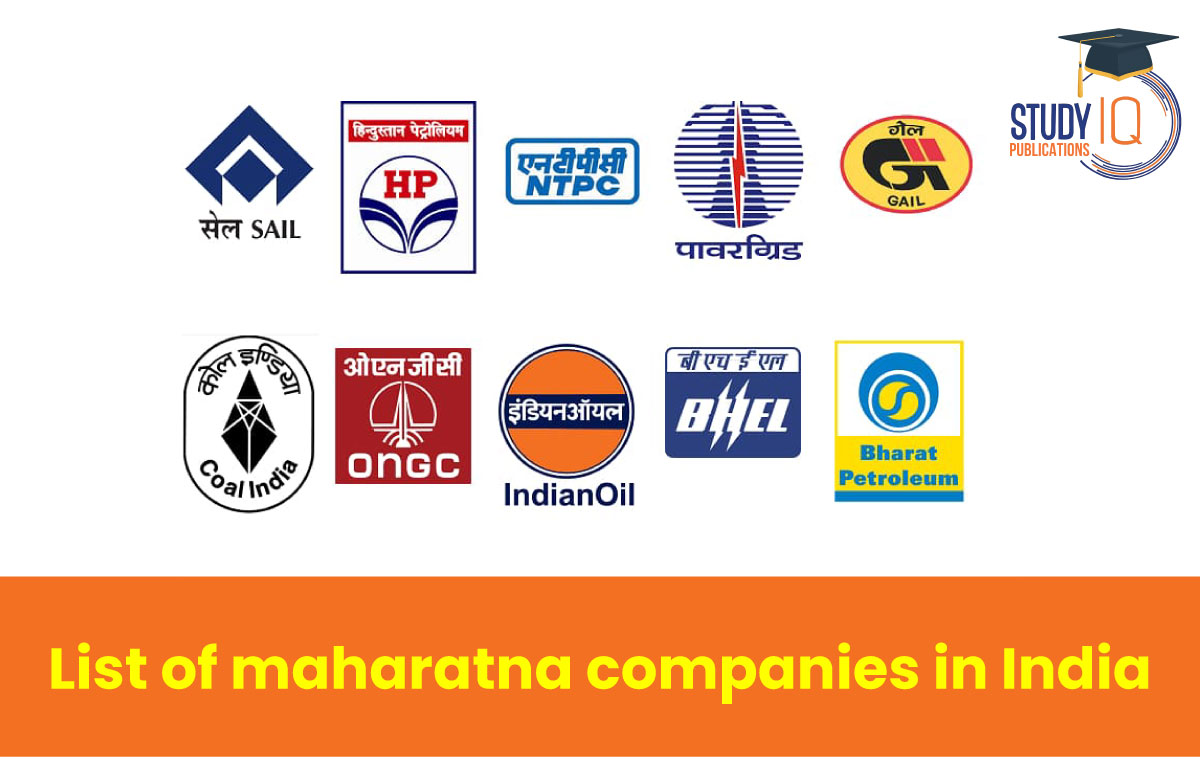Table of Contents
India’s public sector undertakings (PSUs) are categorized into Maharatna, Navratna, and Miniratna based on their financial performance, global presence, and operational efficiency. These companies significantly contribute to India’s economic growth and development. In this article, we will explore the updated list of Maharatna companies in India for 2025 and the criteria for Navratna status.
List of Maharatna Companies in India 2025
India has its businesses that are government-owned and are known as Central Public Sector Enterprises (CPSEs). The government established Maharatna Companies in 2010. These companies are classified as Maharatna Company, Navratna Company, and Miniratna Company, depending on their degree of financial independence. These businesses were founded to give businesses more financial freedom and support their entry into the global market. There are 14 Maharatna Companies in India at the moment. Here’s the complete List of Maharatna Companies in India:
| Company Name | Founding Year | |
| 1 | Bharat Petroleum Corporation Limited (BPCL) | 1952 |
| 2 | Steel Authority of India Limited (SAIL) | 1954 |
| 3 | Oil and Natural Gas Corporation (ONGC) | 1956 |
| 4 | Indian Oil Corporation Limited (IOCL) | 1959 |
| 5 | Oil India Ltd (OIL) | 1959 |
| 6 | Bharat Heavy Electricals Limited (BHEL) | 1964 |
| 7 | Rural Electrification Corporation (REC) | 1969 |
| 8 | Hindustan Petroleum Corporation Limited (HPCL) | 1974 |
| 9 | Coal India Limited (CIL) | 1975 |
| 10 | National Thermal Power Corporation (NTPC) | 1975 |
| 11 | Gas Authority of India Limited (GAIL) | 1984 |
| 12 | Power Finance Corporation (PFC) | 1986 |
| 13 | Power Grid Corporation of India Limited (POWERGRID) | 1989 |
| 14 | Hindustan Aeronautics Limited (HAL) | 2024 |
Note: Hindustan Aeronautics Limited (HAL) was the most recent addition to this esteemed list, achieving Maharatna status in October 2024
What are Maharatna Companies?
In India, a Maharatna Company is one of the national governments that have granted status. These are the businesses that were already Navaratna Companies. It has more financial and administrative freedom, which aids in its expansion and competitiveness on a global scale. Maharatna companies are Central Public Sector Enterprises (CPSEs), Public Sector Banks (PSBs), and State Level Public Enterprises, which are possible categories for public sector entities (SLPEs).
The Ministry of Heavy Industries and Public Enterprises is in charge of managing CPSEs. All Central Public Sector Enterprises are coordinated under the Department of Public Enterprises (DPE), which makes CPSE policy. These regulations primarily deal with staff management, financial autonomy, and performance evaluation and improvement. Additionally, these businesses have more discretion over their investments.
- They put 15% of their net worth, the maximum they can put into a project.
- Maharatna Companies operate with a fair amount of autonomy and are not required to get permission from the government before making any decisions.
- Due to the greater level of operation for these enterprises, their investment cap is set at Rs. 5,000 crores.
| Classification of CPSEs in India |
|
What is ‘Navratna’ Status?
- Navratna status is given to high-performing Public Sector Undertakings (PSUs) for their exceptional financial and market performance.
- It provides financial and operational independence to companies.
Benefits of Navratna Status
- Financial Autonomy: PSUs can invest up to ₹1,000 crore or 15% of their net worth (whichever is lower) on a single project without requiring Central Government approval.
- Operational Freedom: They can form joint ventures, alliances, and subsidiaries independently.
- Recognition & Growth Potential: Companies gain higher market credibility and opportunities for expansion and diversification.
Maharatna Companies Eligibility Criteria
In India, the Companies Act of 2013 governs the establishment of all government-owned businesses. Section 8 of the same Act governs the creation of Indian PSUs. Based on predetermined goals that are both financial and non-financial, they are categorized as Maharatna Companies. The following is a list of requirements that an endeavor must meet to qualify as a Maharatna Company.
- It must be registered as a Navratna Company.
- The Indian Stock Exchange is where it must be listed.
- In accordance with SEBI (Securities and Exchange Board of India) regulations, it must also possess the required public shareholding.
- Over the previous three years, the company should have made a profit after taxes of at least Rs. 5000 crores.
- The company must have had an average net value of Rs. 15,000 over the previous three years.
- The company must operate globally and have an international presence.
Maharatna Companies Benefits
- Due to their position, the Maharatna Companies and their employees are entitled to several perks. These are a few of the most significant businesses in the nation. The following list of Maharatna firms in India’s benefits is offered.
- Maharatna Companies also receive a benefit from investments. They may invest 15% of their total net wealth, or up to Rs. 5,000 crores, in a project that fits their definition.
- Employees of Maharatna Companies are treated the same as those employed by the federal government and are entitled to the same privileges and benefits, including pensions, etc.
- At higher levels, the officers in these companies become Gazetted Officers.
- These businesses are well-known around the world and frequently take part in international projects.
Maharatna Companies in India Details
1. Bharat Heavy Electricals Limited (BHEL)
- It was established in 1956. Later, it was converted into a public company in 1991.
- It is engaged in the design, as well as the engineering,
- The,n the work of manufacturing and construction.
- The company is also involved in testing, commissioning and servicing various products.
- It is the largest company investing in R&D in the corporate sector in India.
- The company has established the capability to deliver 20,000 MW p.a. of power equipment to address the growing demand for power generation equipment.
- The Indian government grants the Central Public Sector Enterprises Statuses:-
- Maharatna
- Miniratna
- Navaratna
- The Ministry of Heavy Industries and Public Enterprises oversees them.
2. Bharat Petroleum Corporation Limited (BPCL)
- It was set up by the Britishers in 1891 to carry out explorations in the Assam and Burma region.
- In 1976, the company was nationalised under the Act on the Nationalisation of Foreign Oil Companies ESSO (1974), Burma Shell (1976) and Caltex (1977).
- It was renamed Bharat Petroleum Corporation Limited on 1 August 1977.
- In 2017, Bharat Petroleum Corporation Limited received the Maharatna Status.
- It is India’s second-largest fuel retailer.
- India’s second-largest government-owned downstream oil corporation.
- It operates under the Ministry of Petroleum and Natural Gas.
- Bharat Petroleum operates the following given refinery:
- Mumbai Refinery
- Kochi Refinery
- Bina Refinery
- Numaligarh Refinery
- Some of its subsidiaries are:
-
- Indraprastha Gas Limited (IGL)
- Petronet LNG
- Bharat Renewable Energy Limited
-
3. Coal India Limited (CIL)
- It was established in 1975.
- Its headquarters is in Kolkata, West Bengal.
- The union government of India gave Coal India Limited the status of Maharatna in April 2011.
- At the global level, it is the largest coal-producing company.
- Some of the subsidiaries of Coal India Limited (CIL) are listed below:
- Western Coalfields Limited (WCL)
- Central Coalfields Limited (CCL)
- Mahanadi Coalfields Limited (MCL)
- South Eastern Coalfields Limited (SECL)
- Bharat Coking Coal Limited (BCCL)
- Eastern Coalfields Limited (ECL)
- Central Coalfields Limited (CCL)
- Northern Coalfields Limited (NCL)
- Central Mine Planning and Design Institute (CMPDI)
- Owned by the Indian government,
- CIL produces the most coal in the world.
- It was established in November 1975 and is currently the seventh-largest employer in the nation.
4. Gas Authority of India Limited (GAIL)
- GAIL was incorporated as a Central Public Sector Undertaking in 1984.
- Initially, it was entrusted with the construction, maintenance and operation of the Hazira Jagdishpur pipeline project.
- Its mission is enhancing quality of life through clean energy and beyond”.
- It owns and operates a network of around 14,488 km of natural gas pipelines.
- It is also working on the execution of multiple pipeline projects to expand the reach of GAIL further.
- It holds approx ~70% of the market share in gas transmission projects in the sphere of gas trading; it holds approx 50% of the share in the country.
- GAIL is also expanding its reach in renewable energy sectors like Solar, Wind and Biofuel.
- India’s Gas Authority Limited -The largest natural gas firm in India, commonly referred to as GAIL, is in charge of processing and distributing natural gas throughout the country.
5. Hindustan Petroleum Corporation (HPCL)
- HPCL was established in 1974.
- It is headquartered in Mumbai, Maharashtra.
- The Government of India acquired it in 2017.
- It was accorded the status of Maharatna in 2019.
- It operates two major refineries in India, one in Mumbai and the other in Visakhapatnam.
- It was featured on the Forbes Global 2000 list for 2013 at position 1217.
- Its main focus is on the appraisal and development of hydrocarbon accumulation of both onshore and offshore projects by exploring and developing petroleum projects in India.
- It manages and runs the two significant refineries in Mumbai and Visakhapatnam.
6. Indian Oil Corporation Limited (IOCL)
- The largest commercial oil company in the nation is Indian Oil Corporation Limited.
- This corporation is the largest commercial oil company in India.
- This corporation has ventured into alternative energy and the globalisation of downstream operations.
- Some of the subsidiary countries of Indian Oil Corporation Limited are given as follows:
- Sri Lanka
- Mauritius
- The Netherlands
- The UAE
- Sweden
- United States of America
- Singapore
- IOCL’s business interests coincide with the hydrocarbon value chain. This chain includes:
- Pipeline transportation
- Refining
- Marketing of Petroleum products
- Exploration and production of crude oil, petrochemicals and natural gas
- 11 of India’s 23 refineries are run by IOCL, which is under the Ministry of Petroleum and Gas.
7. National Thermal Power Corporation (NTPC)
- NTPC is India’s largest energy-producing company, which was established in 1975.
- It was established to provide reliable and efficient power in an economical and environment-friendly manner.
- Since its establishment, it has established itself as one of the major players in the power generation business.
- The company produces electricity not only from fossil fuels but also from other renewable energy sources like hydropower.
- This has accelerated the goal of India’s INDC of achieving a reduction of 33-35% of its carbon footprint by 2030 from 2005 levels, as outlined in UNFCCC.
- The company has further expanded its domain in the fields of trading of power & power professionals, rural electrification and coal mining.
- The company was accorded the status of Maharatna status in May 2010.
- It ranks No 2 among the Top 250 Global power companies in terms of Independent Power Producer.
8. Oil and Natural Gas Corporation (ONGC)
- ONGC is responsible for the production of more than 70% of India’s crude oil as well as key tasks, including gas exploration and production.
- ONGC was set up under the Prime Minister ship of Jawaharlal Nehru as an Oil and Gas division under the Geological Survey of India in 1955.
- Later, it was converted into the Oil and Natural Gas Directorate.
- The Directorate was later converted into a Commission named the Oil & Natural Gas Commission in August 1956.
- In 1994, the Oil and Natural Gas Commission was converted into a Corporation, and later in 1997, it was recognized as one of the Navratnas by the Union Government.
- Subsequently, it was conferred Maharatna status in the year 2010.
- It is the largest crude oil and natural gas Company in India.
- It contributes around 71 per cent to domestic oil and natural gas production.
9. Power Grid Corporation of India (POWERGRID)
- 90% of India’s electricity transmission systems were run by the Power Grid Corporation of India, which distributed the energy first by the state and then by area.
- POWERGRID was established in 1989 under the Companies Act of 1956 as the National Power Transmission Corporation of India Limited.
- Later, its name was changed to POWERGRID in 1992.
- In India, it is one of the largest electric power transmission utilities.
- The Union government has accorded it the status of Maharatna.
- Its headquarters is in Gurugram.
10. Steel Authority of India Limited (SAIL)
- SAIL produces the most steel in India.
- The origin of SAIL can be traced to Hindustan Steel Limited (HSL), which was set up in January 1954.
- It is based in New Delhi.
- SAIL is the largest steel-producing company.
- SAIL has three specialised steel mills and five integrated steel plants.
- Bhilai
- Rourkela
- Durgapur
- Bokaro
- Burnpur
- Three special steel plants at
- Salem
- Durgapur
- Bhadravathi
- It has won the “Best of All” Rajiv Gandhi National Quality Award in 1993, 2006, and 2007 for its Bhilai and Bokaro plants.
11. Power Finance Corporation (PFCL)
- It was established in 1986.
- It was granted the status of Maharatna in October 2021.
- It is the 8th highest profit-making Central Public Sector Enterprise (CPSE) as per the Department of Public Enterprises Survey for FY 2017–18
- Ministry of Power operates.
- It has three wings, each headed by a Functional Director:
- Commercial Division
- Projects Division
- Finance & Financial Operations Division.
- In November 2017, it launched its main Green Bond issue for US$400 million.
12. Rural Electrification Corporation (REC)
- Incorporated in 1969, REC is an India-based Non-Banking Financial Company (NBFC) that specialises in financing and developing the country’s power sector.
- It falls within the Ministry of Power’s purview.
- It has been designated as a Nodal Agency for the following Government of India key programmes-
- Pradhan Person Sahaj Bijli Yojana Har Ghar (SAUBHAGAYA)
- Gram Jyoti Yojana Deen Dayal Upadhaya (DDUGJY)
- Fund for National Electricity (NEF)
13. Oil India Limited (OIL)
- On August 3, 2023, it was granted Maharatna status following a recommendation from the Indian government’s Ministry of Finance.
- Oil India Limited (OIL) is a government-owned enterprise with a central role in exploring, developing, and producing crude oil and natural gas, transporting crude oil and manufacturing liquid petroleum gas.
- The Ministry of Petroleum and Natural Gas oversees its activities.
- OIL’s headquarters are located in
- Duliajan, Assam,
- It maintains offices
- Duliajan
- Noida
- Guwahati
- Jodhpur
14. Hindustan Aeronautics Limited (HAL)
Hindustan Aeronautics Limited (HAL) is a leading Indian aerospace and defense company, headquartered in Bengaluru, Karnataka. It is a government-owned enterprise under the Ministry of Defence, specializing in aircraft manufacturing, avionics, and related aerospace services.
- Founded: 1940 (as Hindustan Aircraft Limited), renamed Hindustan Aeronautics Limited in 1964
- Headquarters: Bengaluru, Karnataka, India
- Ownership: Public Sector Undertaking (PSU) under the Ministry of Defence, Government of India
- Maharatna Status: Achieved Maharatna status in October 2024
- Industry Focus: Aerospace, defense, and aviation
Difference Between Maharatna, Navratna, and Miniratna Companies
| Feature | Maharatna PSUs | Navratna PSUs | Miniratna PSUs |
| Investment Autonomy | Up to ₹5,000 crore or 15% of net worth | Up to ₹1,000 crore or 15% of net worth | Up to ₹500 crore or net worth limit |
| Global Operations | Strong international presence | Moderate global reach | Limited global influence |
| Minimum Net Worth | ₹15,000 crore | Not specified | Not specified |
Conclusion
India’s Maharatna and Navratna companies play a crucial role in infrastructure, energy, and industrial growth. With their financial strength and operational efficiency, they contribute significantly to the country’s economy. Understanding their eligibility criteria helps investors and stakeholders assess their potential and impact on India’s economic landscape.


 List of Awards and Honours Received by N...
List of Awards and Honours Received by N...
 List of GI Tag Products in India 2025, S...
List of GI Tag Products in India 2025, S...
 Hurun Global Unicorn Index 2025: Key Hig...
Hurun Global Unicorn Index 2025: Key Hig...





















